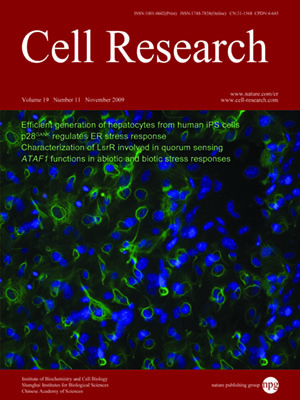Volume 19 Issue 11, November 2009: 1243-1257
ORIGINAL ARTICLES
p28GANK inhibits endoplasmic reticulum stress-induced cell death via enhancement of the endoplasmic reticulum adaptive capacity
Rong-Yang Dai1,2,*, Yao Chen2,*, Jing Fu2, Li-Wei Dong2, Yi-Bin Ren2, Guang-Zhen Yang2, You-Wen Qian2, Jie Cao2, Shan-Hua Tang2, Sheng-Li Yang1 and Hong-Yang Wang1,2
1State Key Laboratory of Oncogenes and Related Genes, Shanghai Cancer Institute and Cancer Institute of Shanghai Jiao Tong University, Shanghai 200032, China
2International Co-operation Laboratory on Signal Transduction, Eastern Hepatobiliary Surgery Institute, Shanghai 200438, China
Correspondence: Hong-Yang Wang,(hywangk@vip.sina.com )
It has been shown that oncoprotein p28
GANK, which is consistently overexpressed in human hepatocellular carcinoma (HCC), plays a critical role in tumorigenesis of HCC. However, the underlying mechanism remains unclear. Here, we demonstrated that p28
GANK inhibits apoptosis in HCC cells induced by the endoplasmic reticulum (ER) stress. During ER stress, p28
GANK enhances the unfolded protein response, promotes ER recovery from translational repression, and thereby facilitates cell's ability to cope with the stress conditions. Furthermore, p28
GANK upregulates glucose-regulated protein 78 (GRP78), a key ER chaperone protein, which subsequently enhances the ER folding capacity and promotes recovery from ER stress. We also demonstrated that p28
GANK increases p38 mitogen-activated protein kinase and Akt phosphorylation, and inhibits nuclear factor kappa B (NF-κB) activation under ER stress, which in turn contributes to GRP78 upregulation. Taken together, our results indicate that p28
GANK inhibits ER stress-induced apoptosis in HCC cells, at least in part, by enhancing the adaptive response and GRP78 expression. We propose that p28
GANK has potential implications for HCC progression under the ER stress conditions.
Cell Research (2009) 19:1243-1257. doi: 10.1038/cr.2009.104; published online 8 September 2009
FULL TEXT | PDF
Browse 2214


